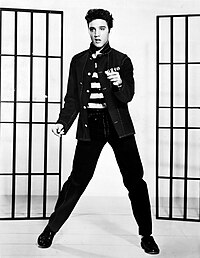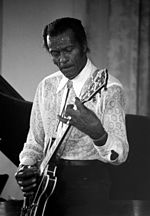Music history of the United States in the 1950s
Mitch Miller, A&R man at the era's most successful label, Columbia Records, set the tone for the development of popular music well into the middle of decade.
Miller often employed novel and ear-catching arrangements featuring classical instruments (whooping french horns, harpsichord), or sound effects (whip cracks).
Nat "King" Cole dominated the charts throughout the decade with such timeless classics as "Unforgettable," "Mona Lisa," "Too Young," "Darling, Je Vous Aime Beaucoup," "Pretend," "Smile," and "A Blossom Fell.
Other major stars in the early 1950s included Frank Sinatra ("Young at Heart," "Three Coins in the Fountain," "Witchcraft"),[6] Tony Bennett ("Cold, Cold Heart," "Because of You," "Rags to Riches"), Kay Starr ("Bonaparte's Retreat," "Wheel of Fortune," "Rock and Roll Waltz"),[3] Rosemary Clooney ("Come On-a My House," "Mambo Italiano," "Half as Much," "This Ole House"), Dean Martin ("That's Amore," "Return to Me," "Sway"), Georgia Gibbs ("Kiss of Fire," "Dance With Me, Henry," "Tweedle Dee"), Eddie Fisher ("Anytime," "Wish You Were Here," "Thinking of You," "I'm Walking Behind You," "Oh!
Music!," "Till I Waltz Again With You," "Ricochet(Rick-O-Shay)"), Doris Day ("Secret Love," "Whatever Will Be Will Be (Que Sera Sera)," "Teacher's Pet"), Guy Mitchell ("My Heart Cries for You," "The Roving Kind," "Pittsburgh, Pennsylvania," "Singing the Blues"), Bing Crosby ("Play a Simple Melody with son Gary Crosby, "True Love with Grace Kelly), Dinah Shore ("Lavender Blue"), Kitty Kallen ("Little Things Mean a Lot"), Joni James ("Have You Heard," "Wishing Ring," "Your Cheatin' Heart"), Peggy Lee ("Lover," "Fever"), Julie London ("Cry Me a River"), Toni Arden ("Padre"), June Valli ("Why Don't You Believe Me"), Arthur Godfrey ("Slowpoke"), Tennessee Ernie Ford ("Sixteen Tons"), Les Paul and Mary Ford ("Vaya Con Dios," "Tiger Rag"), and vocal groups like The Mills Brothers ("Glow Worm"), The Weavers "(Goodnight Irene"),[1] The Four Aces ("Love Is a Many-Splendored Thing", "(It's No) Sin"), The Chordettes ("Mister Sandman"), Fontane Sisters ("Hearts of Stone"), The Hilltoppers ("Trying," "P.S.
Paul's hit records like "How High the Moon," and "The World Is Waiting for the Sunrise," helped lead to the development of a specifically rock and roll style of playing of such exponents as Chuck Berry, Link Wray, and Scotty Moore.
[11] Artists such as Chuck Berry, Bo Diddley, Fats Domino, Little Richard, Jerry Lee Lewis, Big Joe Turner, and Gene Vincent released the initial rhythm and blues-influenced early rock and roll hits.
Rock and roll forerunners in the popular music field included Johnnie Ray, The Crew-Cuts, The Fontane Sisters, and Les Paul and Mary Ford.
"[citation needed] This film's use of Bill Haley and His Comets' "(We're Gonna) Rock Around the Clock" over its opening credits, caused a national sensation when teenagers started dancing in the aisles.
Pat Boone became the first rock and roll teen idol in 1955 with heavily Pop-influenced "covers" of R&B hits like "Two Hearts, Two Kisses (Make One Love)," "Ain't That a Shame", and "At My Front Door (Crazy Little Mama)."
Elvis Presley, who began his career in the mid-1950s, soon became the leading figure of the newly popular sound of rock and roll with a series of network television appearances, motion pictures, and chart-topping records.
Some commentators have perceived this as the decline of rock and roll; citing the deaths of Buddy Holly, The Big Bopper and Ritchie Valens in a tragic plane crash in 1959 and the departure of Elvis for the army as causes.
[14] By the late 1950s, a revival of Appalachian folk music was taking place across the country, and bands like The Weavers were paving the way for future mainstream stars like Bob Dylan and Joan Baez.
Bluegrass was similarly revitalized and updated by artists including Tony Rice, Clarence White, Richard Green, Bill Keith and David Grisman.
Artists like the Five Blind Boys of Mississippi, The Swan Silvertones, Clara Ward Singers and Sensational Nightingales became stars across the country; other early artists like Sam Cooke, Dionne Warwick, Dinah Washington, Johnnie Taylor, Aretha Franklin, Wilson Pickett began their career in gospel quartets during this period, only to achieve even greater fame in the 1960s as the pioneers of soul music, itself a secularized, R&B-influenced form of gospel.
Doo wop singers would work a cappella without backing instruments, and practice in hallways of their schools, apartment buildings, or alleys to achieve echo effects on their voices, and lyrics were generally innocent youthful observations on the upsides of teen love and romance.
Groups like The Crows ("Gee"), The Orioles ("It's Too Soon to Know") and Brooklyn's Frankie Lymon & the Teenagers ("Why Do Fools Fall in Love") had a string of hit songs that brought the genre to chart domination by 1958 (see 1958 in music).
The 1950s also saw success for Mexican ranchera divas, while a Mexican-American mariachi scene was developing on the West Coast, and Puerto Rican plena, Brazilian bossa nova and other Latin genres became popular.
In the mid-1950s, when Mexican ranchera was used in Hollywood film soundtracks and the upper-class enjoyed stately orquestas Tejanas and conjunto evolved into a distinctively Mexican-American genre called Tejano.
The 1940s saw a return to the roots of Cajun music, led by Iry LeJeune, Nathan Abshire and other artists, alongside musicians who incorporated rock and roll, including Laurence Walker and Aldus Roger.


